Related Research Articles
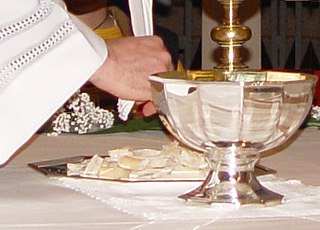
Agnus Dei is the Latin name under which the "Lamb of God" is honoured within Christian liturgies descending from the historic Latin liturgical tradition, including those of Roman Catholicism, Lutheranism and Anglicanism. It is the name given to a specific prayer that occurs in these liturgies, and is the name given to the music pieces that accompany the text of this prayer.
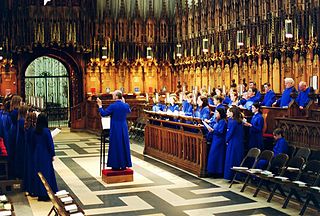
A choir is a musical ensemble of singers. Choral music, in turn, is the music written specifically for such an ensemble to perform. Choirs may perform music from the classical music repertoire, which spans from the medieval era to the present, or popular music repertoire. Most choirs are led by a conductor, who leads the performances with arm, hand, and facial gestures.

Franz Peter Schubert was an Austrian composer of the late Classical and early Romantic eras. Despite his short life, Schubert left behind a vast oeuvre, including more than 600 secular vocal works, seven complete symphonies, sacred music, operas, incidental music, and a large body of piano and chamber music. His major works include "Erlkönig", the Piano Quintet in A major, D. 667 , the Symphony No. 8 in B minor, D. 759 , the "Great" Symphony No. 9 in C major, D. 944, the String Quintet, the three last piano sonatas, the opera Fierrabras, the incidental music to the play Rosamunde, and the song cycles Die schöne Müllerin and Winterreise.
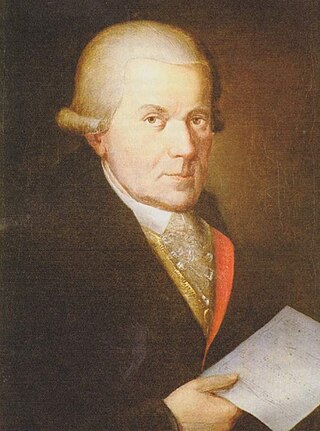
Johann Michael Haydn was an Austrian composer of the Classical period, the younger brother of Joseph Haydn.
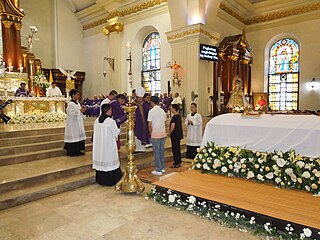
A Requiem or Requiem Mass, also known as Mass for the dead or Mass of the dead, is a Mass of the Catholic Church offered for the repose of the soul or souls of one or more deceased persons, using a particular form of the Roman Missal. It is usually celebrated in the context of a funeral.

The Mass is a form of sacred musical composition that sets the invariable portions of the Christian Eucharistic liturgy, known as the Mass.
Sir Donald Tovey's Essays in Musical Analysis are a series of analytical essays on classical music.
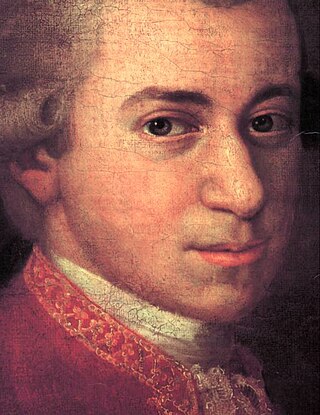
The Requiem in D minor, K. 626, is a requiem mass by Wolfgang Amadeus Mozart (1756–1791). Mozart composed part of the Requiem in Vienna in late 1791, but it was unfinished at his death on 5 December the same year. A completed version dated 1792 by Franz Xaver Süssmayr was delivered to Count Franz von Walsegg, who had commissioned the piece for a requiem service on 14 February 1792 to commemorate the first anniversary of the death of his wife Anna at the age of 20 on 14 February 1791.

Church music is Christian music written for performance in church, or any musical setting of ecclesiastical liturgy, or music set to words expressing propositions of a sacred nature, such as a hymn.

An art song is a Western vocal music composition, usually written for one voice with piano accompaniment, and usually in the classical art music tradition. By extension, the term "art song" is used to refer to the collective genre of such songs. An art song is most often a musical setting of an independent poem or text, "intended for the concert repertory" "as part of a recital or other relatively formal social occasion". While many pieces of vocal music are easily recognized as art songs, others are more difficult to categorize. For example, a wordless vocalise written by a classical composer is sometimes considered an art song and sometimes not.
Roman Hurko is a New York based composer who specializes in Byzantine Rite Music.
Eugene Concert Choir is a choral masterworks organization in Eugene, Oregon, that consists of three performing ensembles: the 100-voice Eugene Concert Choir (ECC), the 36-voice chamber choir Eugene Vocal Arts (EVA), and the associated professional chamber orchestra Eugene Concert Orchestra.
The Liturgy of St. John Chrysostom is an a cappella choral composition by Pyotr Ilyich Tchaikovsky, his Op. 41, composed in 1878. It consists of settings of texts taken from the Divine Liturgy of St. John Chrysostom, the most celebrated of the eucharistic services of the Eastern Orthodox Church. Tchaikovsky's setting constitutes the first "unified musical cycle" of the liturgy.

Psalm 92 is the 92nd psalm of the Book of Psalms, beginning in English in the King James Version: "It is a good thing to give thanks unto the LORD". In the slightly different numbering system used in the Greek Septuagint and Latin Vulgate translations of the Bible, this psalm is Psalm 91. In Latin, it is known as "Bonum est confiteri Domino ". The psalm is known as Mizmor Shir L'yom HaShabbat, is ostensibly dedicated to the Shabbat day.
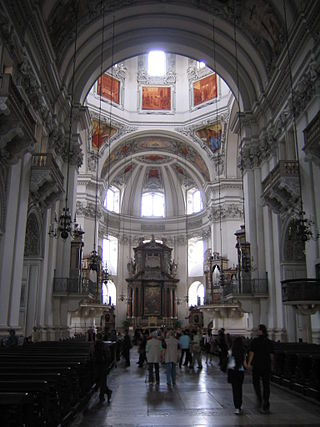
The Sparrow Mass is a mass in C major K. 220/196b, Mass No. 9, Missa brevis No. 5, composed by Wolfgang Amadeus Mozart in 1775 or 1776 in Salzburg. The mass is sometimes termed a missa brevis et solemnis, because it is short in a simple structure as a missa brevis, but festively scored like a missa solemnis with brass and timpani in addition to four soloists, strings and organ. It was possibly first performed on 7 April 1776 in a mass for Easter at the Salzburg Cathedral. The nickname is derived from violin figures in the Hosanna which resemble bird chirping.

Monmouth Civic Chorus is a community chorus in Monmouth County, New Jersey, USA. Monmouth Civic Chorus was established in 1949 and draws its members primarily from the Monmouth County community. Its performances encompass choral classics, premieres, rare and contemporary music, musical theater, opera, and operetta. Monmouth Civic Chorus has performed on tour in Europe and the Mid-Atlantic region of the United States.
The Liturgy of St. John Chrysostom is the musical setting of the Divine Liturgy of St. John Chrysostom by Mykola Leontovych. Consistent with Orthodox tradition, in which service is sung exclusively a cappella, the piece is set for unaccompanied choir and soloist. It was first performed in the Mykolaiv Cathedral at the Kyiv Pechersk Lavra on May 22, 1919, with Leontovych himself conducting.
The Music for the Requiem Mass is any music that accompanies the Requiem, a Mass in the Catholic Church for the deceased. It has inspired a large number of compositions, including settings by Mozart, Berlioz, Donizetti, Verdi, Bruckner, Dvořák, Fauré and Duruflé. Originally, such compositions were meant to be performed in liturgical service, with monophonic chant. Eventually the dramatic character of the text began to appeal to composers to an extent that they made the requiem a genre of its own, and the compositions of composers such as Verdi are essentially concert pieces rather than liturgical works.
References
- ↑ Definition Cambridge dictionary
- ↑ Definition Oxford dictionary
- ↑ Arrangement, Encyclopædia Britannica online
- ↑ Randel, Don Michael (2003), The Harvard Dictionary of Music, Harvard University Press, p. 61, ISBN 0-674-01163-5 , retrieved 2012-10-22